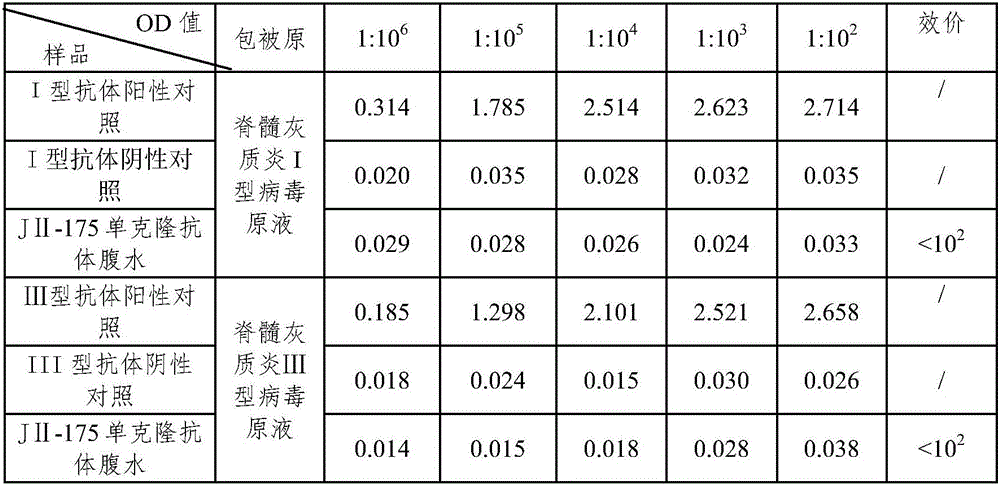Poliovirus type II monoclonal antibody and application thereof
A monoclonal antibody and polio technology, applied in the field of immunology, can solve the problems of good preparation specificity, inability to distinguish D antigen and C antigen well, and inability to truly reflect type II antigen vaccine type II immunogenicity, etc. , to achieve good virus-specific effect
- Summary
- Abstract
- Description
- Claims
- Application Information
AI Technical Summary
Problems solved by technology
Method used
Image
Examples
Embodiment 1
[0035] Example 1 Immunogen preparation and animal immunization
[0036] (1) Take the Vero cell working cell bank and culture it at 36.5±0.5°C after recovery until the cell concentration is 0.1-10×10 6 cells / ml, the virus was inoculated.
[0037] (2) Inoculate Vero cells with working seed batch prepared by Sabin strain poliovirus type II virus at MOI=5-0.1, and culture at 32.5±0.5°C.
[0038] (3) The virus was cultured for 2-4 days, and the cell supernatant was harvested, which was the Sabin strain poliovirus type II virus harvesting liquid.
[0039] (4) Type II virus harvest liquid is clarified and concentrated by ultrafiltration membrane bag for more than 10 times.
[0040] (5) Then carry out molecular sieve chromatography and ion exchange chromatography, the monitoring wavelength is 280nm, respectively collect eluent and flow-through liquid to obtain purified liquid, and obtain purified and inactivated Sabin strain poliomyelitis II after formaldehyde inactivation Type vir...
Embodiment 2
[0043] Example 2 Cell fusion and strain establishment
[0044] (1) Recover and culture the SP2 / 0 cell line before cell fusion, expand the culture 3 days before fusion, remove RPMI 1640 cell culture medium (Gibco) 1 day before fusion, and add culture medium again to prepare SP2 / 0 cells.
[0045] (2) The immunized mice were sacrificed, and the mouse splenocyte suspension was prepared according to conventional methods.
[0046] (3) Add an appropriate amount of incomplete IMDM culture medium (Gibco) according to the counting results of splenocytes and SP2 / 0 cells, shake and mix the SP2 / 0 cells, and pipette the splenocytes evenly. Then the splenocytes and SP2 / 0 cells were mixed in a 50ml centrifuge tube at a ratio of 1:2 to 10:1, and mixed well.
[0047] (4) Add incomplete IMDM culture medium to 50ml, centrifuge for 5-10 minutes, and pour out the supernatant. Lightly tap the bottom of the fusion tube to loosen and evenly precipitate the cells, and place the centrifuge tube in a 3...
Embodiment 3
[0055] Example 3 Monoclonal Antibody Cell Line Ascites Preparation and Antibody ELISA Titer Detection
[0056] Resuscitate the frozen hybridoma cells obtained in Example 2 according to conventional methods, and cultivate them. When the cells cover more than 50% of the bottom of the 25ml cell culture bottle, BALB / c mice can be inoculated intraperitoneally according to conventional methods, and the ascites can be collected regularly. JII-175.
[0057] Dilute the purified and inactivated Sabin strain poliomyelitis type Ⅱ virus with 0.01M PBS 1:200, coat 100 μl / well on the microtiter plate, overnight at 2-8°C, then add 100 μl / well 1:10 2 Initially 10-fold serially diluted negative control and JII-175 monoclonal antibody ascites, react at 37°C for 1 hour, add 1:4000 diluted HRP-labeled goat anti-mouse secondary antibody at 100 μl / well, react at 37°C for 1 hour, wash Plate, color development, termination, read OD450nm, thus detect the indirect ELISA antibody titer of the poliotype ...
PUM
| Property | Measurement | Unit |
|---|---|---|
| recovery rate | aaaaa | aaaaa |
Abstract
Description
Claims
Application Information
 Login to View More
Login to View More - R&D
- Intellectual Property
- Life Sciences
- Materials
- Tech Scout
- Unparalleled Data Quality
- Higher Quality Content
- 60% Fewer Hallucinations
Browse by: Latest US Patents, China's latest patents, Technical Efficacy Thesaurus, Application Domain, Technology Topic, Popular Technical Reports.
© 2025 PatSnap. All rights reserved.Legal|Privacy policy|Modern Slavery Act Transparency Statement|Sitemap|About US| Contact US: help@patsnap.com



